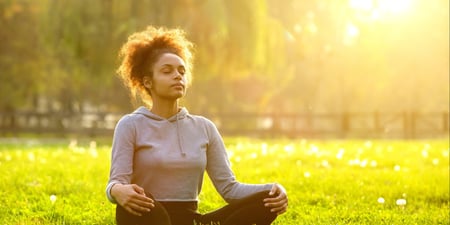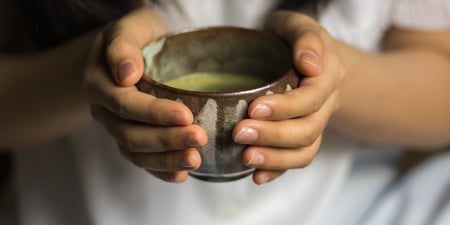
Two Victorian women are working together to improve death literacy and help protect the planet by generating awareness of the green options when it comes to burial or cremation.
Sisters Tamsin Ramone and Alyssa Wormald are co-directors of Heaven and Earth Eco Burial Products[1], in Victoria. Motivated purely by their environmental conscience rather than a first-hand experience of death, they established the business in 2020 to offer people a green alternative at the end of life, primarily supplying shrouds for burial.
“Our desire comes fully out of our care and concern for the environment,” explained Tamsin.
“Before we got into this we thought there were two options - cremation - or burial in a coffin. We hope our work can facilitate more choice in death care and promote the restoration of the ancient healing ritual of shrouding our loved ones and returning them naturally to the Earth.”
The practice of shrouding dates back thousands of years[2] and with the rapid rise in environmental consciousness, is returning as an increasingly popular option for “green burial”, along with cardboard or wicker coffins, biodegradable urns and natural bushland graves[3].
Despite more eco-friendly options on offer, Tamsin and Alyssa point out that many of these, along with conventional methods of burial and cremation, are still seriously damaging to the environment.
“We are rapidly running out of space in cemeteries and older style burials are just so environmentally unfriendly,” Tamsin said.

“People who consider themselves green have no idea that conventional burials cause such a problem once we explain it to them.
“With a regular coffin and gravesite, you’re basically wrapped in plastic and you’ll sit in a concrete box for many, many years and eventually turn into methane gas!
“Sometimes people feel out of their comfort zone with the idea of a shroud - we are working to make people aware that it’s really ok to be buried in one.”
For people who genuinely care for the environment, the sisters’ business is aiming to support people in returning to the earth the same way they lived, in parallel with their values.
“We entered this field because we value people and their connections to each other and the Earth, and we’re proud to offer products that help honour those values at the end of life,” Alyssa said.
The pair are actively involved in lobbying for more accessibility to green burials through local councils and the Natural Death Advocacy Network[4]; as well as increasing awareness in the community by attending markets, giving talks and hosting regular “Death Cafe”[5] events - where they set up in a local cafe and invite people to discuss all things death.
“We want people to know the incredible number of options that legally exist with death and dying, but people just don’t want to talk about it,” said Tamsin. “People say ‘Oh, I’m not planning on dying anytime soon!’”
Alyssa believes the more people talk about death, the more empowered and wiser they become about their options - which she hopes are greener ones.
“Greener burials are just ripe for change - it’s something we can all so easily do and it doesn’t negatively impact anyone - it’s a matter of getting more people to understand and embrace the idea,” she said.
The sisters have five children between them, and their Instagram page, Morbid Mums[6], demonstrates their efforts to make death a completely natural part of life, with photos of their kids alongside their products and joining them on visits to local green cemeteries.
“To have this awareness of mortality gives you a strong foundation for life,” Tamsin said. “You appreciate your life and every single day that you have with your loved ones. It’s actually a gift.”

The Environmental Impacts Of Death
Breaking down the environmental impacts of burial, Tamsin and Alyssa explain it this way[7].
Coffins
“Caskets can be made of hardwoods that are not only often made from old growth forests but are also usually chemically lacquered. Since they are significantly more solid than shrouds, they take more energy to burn and the chemicals from the lacquer are released into the atmosphere.
“Cardboard coffins are a popular choice for cremation as they are less expensive, and take less energy to burn. Whilst cardboard is a more environmentally sustainable option, it is worth bearing in mind that cardboard coffins often contain toxic formaldehyde, are usually not made from fully recycled materials and a significant amount are imported from overseas which adds carbon miles.”
Cremation
Of the 128,500 people that die each year in Australia, 54 per cent are cremated[8], with that figure increasing by half a percent each year.
“The average cremation uses 106 litres of fuel to completely consume a body, emitting approximately 45 kilograms of carbon dioxide into the atmosphere Every cremation releases between .8 and 5.9 grams of mercury as bodies are burned, 75% goes into the air and the remainder ends up settling into the earth and water.
“If a body has been embalmed this adds another foreign product to the mix, during the cremation process the embalming fluid is released into the atmosphere via the crematorium flue, which has the potential to settle into the groundwater and circulate throughout the environment.”
Ashes (Cremains)
“During the cremation process, every part of the body is burned away leaving just bone matter - these parts are then pulverised and turned into the customary ash-like remains. The cremation process changes the chemical composition of the bone, locking the mineral nutrients within it. This sets cremains apart from fireplace ash or blood and bone and causes them to actually be harmful to plant life.
“Cremains are also extremely high in sodium, 200-2000 times too high for the average plant to handle. In addition to this, the pH level of cremains is 12-14, which is the same level as household bleach and almost a million times too high for sustaining plants in their oxidised state. Most plants need a level of around 6.4 to be able to unlock the nutrients within the remains and actually benefit from their introduction to their soil.”
If you’d like to connect with an end-of-life doula, you will find practitioners here, and you can learn more about one of these practitioners in this interview:
References
1. Home. Heaven and Earth Eco Burials; [cited on 2025 Jan 2].
2. Burial Customs and Popular Religion from 1500 to 1690. Encyclopedia.com; [cited on 2025 Jan 2].
3. More Queensland councils to offer natural burials following push for environmental, cultural options. ABC News; 2021.
4. Home. NDAN; 2025.
5. What is Death Cafe? Death Cafe; [cited on 2025 Jan 2].
6. morbidmums. Instagram; [cited on 2025 Jan 2].
7. Ramone T. Cremation and its Environmental Concerns. Heaven & Earth; 2023.
8. Disposing of the dead - Cremation. The Australian Museum; 2021.
Disclaimer: This Content has been developed from our generous global community and is intended for informational purposes only. This Content is not, nor is it intended to be, a substitute for professional medical advice, diagnosis, or treatment and should never be relied upon. Further, the personal views and experiences published are expressly those of the author, and do not represent the views or endorsement of SoulAdvisor through the act of publication on our site.















